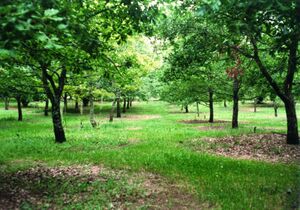Allelochemical

An allelochemical is a compound produced by some species of plants, animals, or microbes as a defense against herbivores or competitors. These chemicals can be released from roots into the soil which suppress or kill neighboring plants that absorb the chemical, such as by altering the amount of chlorophyll the victimized plant produces. Sometimes the allelochemicals are released in a gaseous form from pores in leaves, or just remain in the leaves and until they drop onto the ground where they decompose to release the compound into the soil.[1]
Black walnut leaves, buds, roots, and nut hulls contains juglone, a respiratory inhibitor for some plants. Other allelopathic plants include tree of heaven, fragrant sumac, rice, pea, and sorghum.[1]
Allelochemicals can create persistent problems in soil, even after removing the plant, which may make some sites unsuitable for some plants.[1]